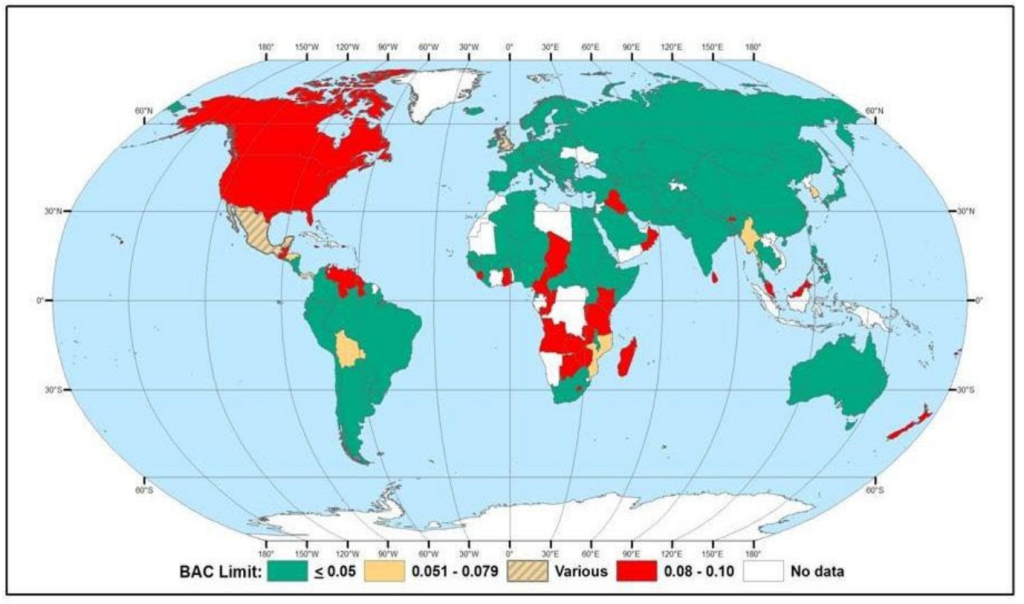
A newly released revamp of Washington State’s Target Zero road safety plan offers policymakers a potential blueprint for reversing the recent trend of increasing traffic fatalities and serious injuries. At the top of the list is a push to reduce the state’s blood-alcohol content threshold for a driving under the influence (DUI) citation from 0.08% to 0.05%, a standard that is becoming the norm around the world.
Washington’s traffic safety experts say the move could save dozens of lives every year, but the change has faced significant headwinds in the state legislature, thanks in part to strong pushback from the hospitality and alcohol industries.
This update is the seventh refresh of the state Target Zero plan since 2000, when Washington became the first state in the country to commit to eliminating serious injuries and fatalities from traffic crashes. The plan issues a call for “bold and urgent action,” as current traffic safety trends are heading in the wrong direction. Washington roads saw 85% more fatalities and 78% more serious injuries in 2023 than in 2013. Those 2023 traffic fatality totals returned the state to numbers not seen since the early 1990s.

There’s no one single cause behind this increase. The plan identifies an alarming rise in multiple high-risk driving behaviors as a major factor, with a 29% increase in fatalities tied to impairment between 2020 and 2022 compared to the prior three years, and a 25% increase in fatalities tied to exceeding posted speed limits.
“For nearly a century, our state and our country have favored fast, efficient travel by private automobile. Continuing on this path is not safe or sustainable,” Governor Jay Inslee noted in an introduction letter to the plan. “This 2024 Target Zero Plan outlines the strategies and tactics that will help us save thousands of lives if we all dedicate ourselves to this important task.”
Moving to 0.05% blood-alcohol limit
Washington’s Traffic Safety Commission has elevated the issue of lowering Washington’s blood-alcohol content (BAC) threshold in recent years, prioritizing the change in messaging to lawmakers and emphasizing its potential to make a significant impact on traffic fatalities. But the move has never been included in the state’s Target Zero plan before, with the 2019 version instead only noting that the Washington Impaired Driving Advisory Council (WIDAC) would continue to research the issue.
Now the plan is unequivocal, with the establishment of a 0.05% limit the very first recommendation. This move comes 11 years after the National Transportation Safety Board recommended all 50 states, Puerto Rico and Washington D.C. adopt a 0.05% limit to stem the tide of alcohol-related traffic fatalities.
“The 0.05% BAC limit is the most common standard internationally, and it has been found to reduce alcohol-involved fatal crashes by 11% on average across several countries studied. In Washington, there were more than 1,100 fatal crashes involving alcohol-positive drivers over the last decade,” the new Target Zero plan states. “Norway established the first per se BAC limit for DUI at 0.05% in 1936. Since then, BAC limits of 0.05% or lower (e.g., 0.03% in Japan and 0.02% in parts of the European Union) have been set in countries that are home to 84% of the world’s population.”

A bill to lower the blood-alcohol limit in Washington State has now failed in three consecutive legislative sessions, making it onto the Senate’s floor calendar in 2023 but not even advancing beyond a single hearing in the House in 2024. House Bill 2196, sponsored by Representative Brandy Donaghy (D-44, Snohomish), garnered just three other co-sponsors, an illustration of how controversial the issue remains. That’s in spite of broad unanimity across public health officials that this is the direction that the state should be moving.
“Fatal traffic accidents are increasing in our state, and over half involve an impaired driver,” Tao Kwan-Gett, the chief science officer for the Washington Department of Health, said testifying in support of the bill this past January. “Science tells us that the driving performance of virtually all drivers is impaired above a blood-alcohol concentration of 0.05%, the new limit proposed by this bill. Above this proposed limit, the typical person has already started to experience impaired judgement, reduced inhibition, and the loss of small muscle control including eye focus.”
Traffic safety officials argue that lowering the BAC limit will have a strong deterrent effect, influencing decisions about when to get behind the wheel, without impacting overall alcohol sales or resulting in increased traffic stops. But leaders in the hospitality and craft beverage industries argue that lowering the limit will have the effect of increasing liability on servers and bartenders, who are already liable under state law for overserving.
“We do share the goal of trying to eliminate impaired driving on our roads, we just don’t think lowering the BAC level to 0.05% is the right approach,” Daniel Olson, executive director of the Washington Brewer’s Guild, said during testimony. “We believe it will put our staff and our breweries at risk, when there is no training that exists for our staff to be able to identify somebody who has reached a 0.05% level. We focus on signs of impairment, and at a 0.05% level, it’s virtually impossible to identify.”
Overhauling driver education to improve safety
The overhauled Target Zero plan also includes an entire slate of recommendations for lawmakers when it comes to driver education reform. In recent years, participation in systemic driver training programs has sharply fallen off, with fewer than half of the drivers aged 18-25 currently on Washington’s roadways having completed a driver’s education course. Current state law includes a loophole requiring teenagers to complete a driver’s ed course at aged 16 and 17 but with no requirement when they turn 18, a fact that seems to be having a significant impact on the crash rates for younger drivers.
“Novice drivers licensed at age 18-20 years old with no driver training prior to licensure had a 78% higher rate of fatal and injury crash involvement, compared to same-age drivers who had completed driver training,” the plan notes. “Slightly older drivers also showed a significant difference in crash rates between those who have and have not completed driver training. Specifically, drivers age 21-24 who lacked driver education had crash rates that were 67% higher compared to their peers who had completed a driver training course.”

The plan recommends first-time driver’s license holders be required to complete a driver education course through age 24, compared to the current requirement of through age 17. With cost being a significant barrier to actually being able to complete those courses, the plan also recommends lawmakers prioritize financial assistance programs.
More broadly, the plan pushes for the expansion of driver education programs statewide. “Policy makers can increase access to driver education by reducing the cost for students generally or subsidizing the cost for low-income drivers specifically. Tribal representatives identified this need, seeking more funding for programs in rural areas that serve Tribal populations and an education incentive program,” the plan states.
The entire 228-page plan touches on many other areas beyond blood-alcohol content and driver education, including the need to continue to invest in active transportation infrastructure, and improve roadway design to prioritize safety over speed and throughput. It remains to be seen just how much attention the issue of roadway safety will receive in the coming years, after a significant push in 2023 resulted in very few tangible wins.
The 2024 election brought significant turnover at the state legislature and the state executive. Governor-Elect Bob Ferguson is about to take office in January with a new state transportation secretary in tow, but, given how little the issue of traffic safety came up on the campaign trail, it’s not clear what direction he will take the state on the issue.
Washington State remains very good at making plans, but its track record of successfully implementing them is much less impressive, even when not going through a gubernatorial transition.
Ryan Packer has been writing for The Urbanist since 2015, and currently reports full-time as Contributing Editor. Their beats are transportation, land use, public space, traffic safety, and obscure community meetings. Packer has also reported for other regional outlets including BikePortland, Seattle Met, and PubliCola. They live in the Capitol Hill neighborhood of Seattle.

